VARROA MITES INFESTING HONEY BEE COLONIES
by Ric Bessin, Extension Entomologist University of Kentucky College of Agriculture
Varroa mites were first reported in Kentucky in the Bluegrass region of the Commonwealth in 1991. They have spread to and become a major pest of honey bees in many states since their introduction into Florida in the mid 1980’s.
 Varroa mites are external honeybee parasites that attack both the adults and the brood, with a distinct preference for drone brood. They suck the blood from both the adults and the developing brood, weakening and shortening the life span of the ones on which they feed. Emerging brood may be deformed with missing legs or wings. Untreated infestations of varroa mites that are allowed to increase will kill honeybee colonies. Losses due to these parasitic mites are often confused with causes such as winter mortality and queenlessness if the colonies are not examined for mites.
Varroa mites are external honeybee parasites that attack both the adults and the brood, with a distinct preference for drone brood. They suck the blood from both the adults and the developing brood, weakening and shortening the life span of the ones on which they feed. Emerging brood may be deformed with missing legs or wings. Untreated infestations of varroa mites that are allowed to increase will kill honeybee colonies. Losses due to these parasitic mites are often confused with causes such as winter mortality and queenlessness if the colonies are not examined for mites.
The adult female mites are reddish-brown in color, flattened, oval, and measure about 1 to 1.5 mm across. They have eight legs. They are large enough to be seen with the unaided eye on the thorax, most commonly, and on the bee’s abdomen. Their flattened shape allows them to hide between the bee’s abdominal segments. This mite is often confused with the bee louse, but the bee louse has only six legs, is more circular in shape, and is slightly larger.
Mites develop on the bee brood. A female mite will enter the brood cell about one day before capping and be sealed in with the larva. Eggs are laid and mite feed and develop on the maturing bee larva. By the time the adult bee emerges from the cell, several of the mites will have reached adulthood, mated, and are ready to begin searching for other bees or larvae to parasitize. There is a preference for drone brood. Inspection of the drone brood in their capped cells will often indicate whether or not a colony is infested. The dark mites are easily seen on the white pupae when the comb is broken or the pupae are pulled from their cells.
Mites spread from colony to colony by drifting workers and drones within an apiary. Honey bees can also acquire these mites when robbing smaller colonies. It is best to isolate captured swarms, package bees, and other new colonies from other colonies and examine them for mites before placing them in an apiary.
Early detection of low levels of mite infestations is key to its successful management.
While they can be spotted during colony inspection if present in high numbers, this tends to only identify larger infestations. There is a product available, Apistan, that will kill the mites and cause the mites to drop from the bees. Two strips should be hung in the brood nest area of the colony for approximately 4 weeks. This is to be used with sticky paper and a fine-mesh screen on the bottom board of a colony to capture any mites that may have been present. A considerable amount of cell cappings and other debris will also collect on the sticky paper, so it is best to inspect the sticky paper carefully for mites after removal. This method is able to detect low level infestations. Apistan strips are available from most of the large beekeeping suppliers and can be used both for detection and treatment of varroa infestations.
If a colony is found to be infested, all colonies at the site should be treated for mites with Apistan strips in the same manner. These strips contain the miticide fluvalinate and are not to be used during honey flow, or when there is surplus honey present in the colony that may be removed for human consumption at a later date. Therefore, late fall, after removal of surplus honey, or early spring, prior to honey flow, are the best times to treat for varroa mites.
Always carefully follow all label instructions with regard to the storage, use and disposal of pesticides.
Revised: 10/01
CAUTION! Pesticide recommendations in this publication are registered for use in Kentucky, USA ONLY! The use of some products may not be legal in your state or country. Please check with your local county agent or regulatory official before using any pesticide mentioned in this publication.
Of course, ALWAYS READ AND FOLLOW LABEL DIRECTIONS FOR SAFE USE OF ANY PESTICIDE!
Managing the Varroa mite
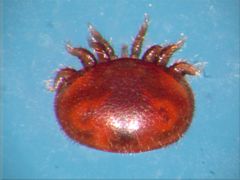
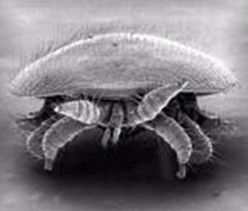
What is a Varroa mite and how did it get here?
The mite is an external parasite of the honeybee, it originated from Asia and spread across Europe to the UK. The mite feeds off the adult bee and brood and whilst doing so it spreads harmful pathogens such as bee viruses. It causes the colony to become weak and if not managed the colony will collapse and die.

Varroa travelled all the way from Asia to Ireland
Reproduction & Life-Span
The adult female mite enters the brood cell just before it is capped, mostly the drone (male) bee cell because it is bigger and allows more room for breeding. She then proceeds to nourish off the immature bee in the cell. After 60-70 hours she lays the first eggs.
The male mite is born first because it has to mate with the other mites before the bee emerges because it does not live outside the cell. All the fertilised females leave to accommodate other open cells to repeat the process.
Because of Varroa’s reproduction cycle, they can return in staggering levels despite treatments in the previous years. Therefore treatment and management is recommended every year.
The life-span also depends on the quantity of brood, they can live up to 27 days in the summer to 5 months during the winter where there is a lack of brood they spend there time solely on the bodies of the adult bees. In the summer they can complete 3-4 breeding cycles.
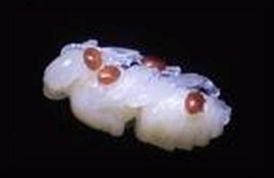
Mites on a removed Pupa
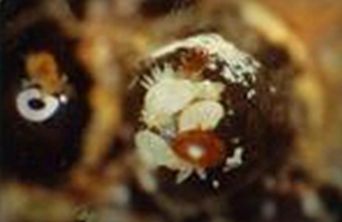
Mites on a pupa in the cell
How it Spreads
The mite is transferred from bee to bee in the hive, and then from colony to colony when a bee drifts, robs from another hive or swarms – this accounts for short distance spreading of Varroa.
Larger distance spreading is caused by infested colonies being transported around by beekeepers or commercial keepers who move their bees long distances seeking flowering crops.
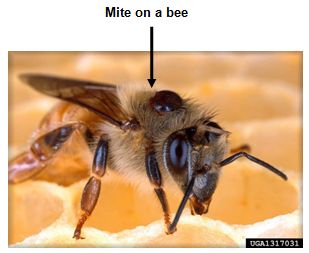
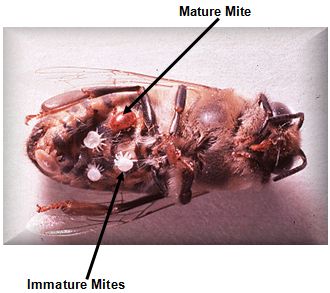
What to Look Out for!
Most of the bees live to emerge from the cell despite being attacked in the cell as it matures, but some do die during its pupal-stage.
The bee has a shorter life span and is often weak and suffers weight loss. Another sign on an emerged bee is shrunken or deformed wings, reduced resistance to infections and finally patches of neglected or dead brood.
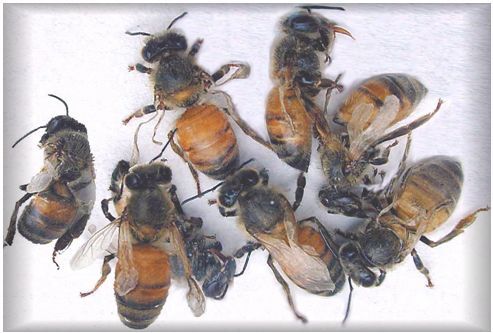
Bees with deformed wings
How to Monitor for mites
You should check or carry out a mite drop survey at least four times a year. This should be done in early spring, after the spring honey flow, at the time of the honey harvest and again in the autumn.
Whichever treatment you use always use a varroa mesh floor with a sampling tray, you can use the tray for carrying out a mite count, the mites will fall off the bees through the mesh onto the tray where you can carry out an accurate mite count to check for infestation.
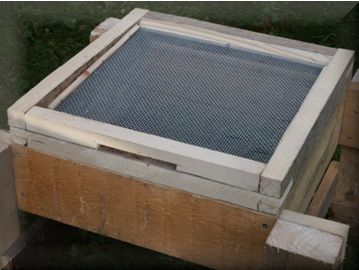
A Varroa mesh floor
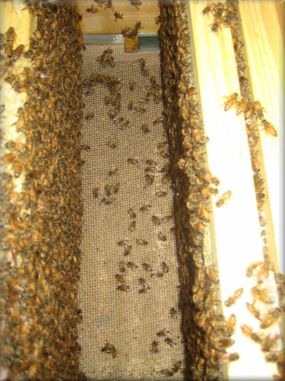
A Varroa mesh floor, when looking down through the frames
Mite Drop Count – A measure of Natural Mortality
Scientific research carried out in the UK suggests that the colony risks collapsing if the mite count exceeds:
- Winter/Spring = 0.5 mites
- May = 6 mites
- June = 10 mites
- July = 16 mites
- August = 33 mites
- September = 20 mites
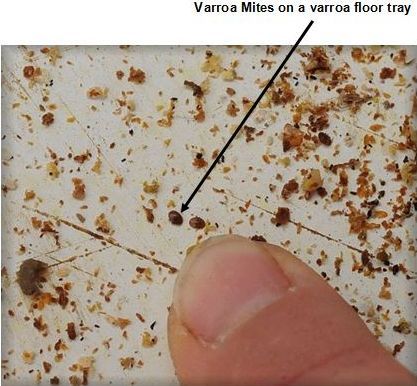
The Aim of Varroa Control
The aim of all good beekeepers is to keep the mite population below the level that is likely to do harm to the colony, reduce the risk of bee’s diseases, reduce the risk of colonies collapsing and to maintain healthy strong colonies of bees.
The more mites that are left behind the quicker they will build up to harmful levels, with 80% efficiency the danger level of 1,000 mites is reached again in 65 days and with 90% in 100 days.
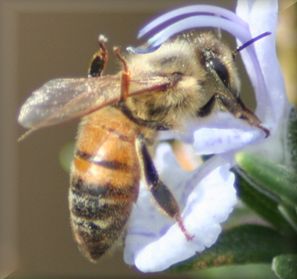
A healthy bee
Varroa Control Methods
The types of controls can be divided into two main categories:
- Biotechnical: Using bee-husbandry through physical means i.e. trapping the mite and then destroying it and
- Varroacides: Using chemicals or fumigants.
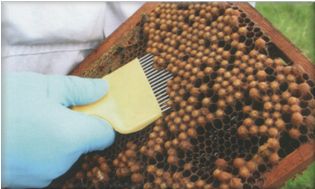

Removing Drone Brood (Biotechnical – to left) and Using Chemicals or Fumigants (Varroacides – to right)
Biotechnical Methods
Drone Brood Removal:
You can promote drone laying, by either using drone foundation, scoring drawn comb or other methods. Before the drone bees emerge from the cells, remove and destroy them, you will see the mites attached to the pupa.
This procedure can be carried out several times throughout the year but can be very time consuming. Although a useful method it has limited efficacy.
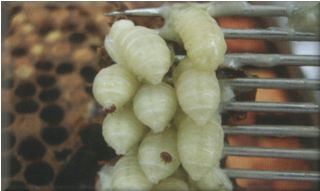
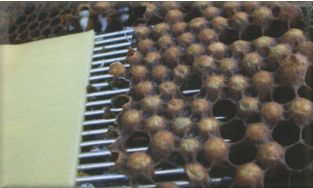
Drone Pupa with mites (to left) and removing Drone Brood (to right)
Comb Trapping:
Cage the queen for 9 days on three combs in succession, these then remain in the colony for a further 9 days while the Varroa enter the brood cells. The combs containing trapped mites in sealed brood are then removed and destroyed.
This method is very time consuming and requires good beekeeping skills. Timing is crucial in this method and you can weaken the colony if not done correctly.
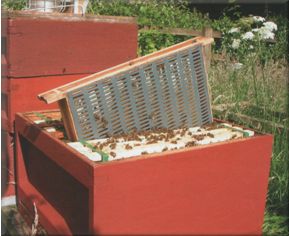
Brood box with a comb trap fitted
Artificial Swarm:
Move the parent colony at least 4 metres away from its original position, put a second hive and the queen in the original place and allow for foragers to return creating an artificial swarm.
After 9 days remove all but one queen cell from the parent hive, leave the virgin queen in a queen cage so she can’t mate but can be cared for. After 3 weeks all the brood in the parent hive will have hatched, then transfer two bait combs of unsealed brood into the parent hive.
Once the brood is capped, remove and destroy them. Cull the queen and introduce a new queen to the parent colony, the old queen in the swarm can later be removed and the two colonies reunited
This method is only suitable during the swarming seasons and you run a high risk of the bees absconding. For more detailed information, please see the article on artificial swarming by clicking here…
Mesh Floor:
Fit a mesh-monitoring floor (without a collection tray) to the hive under the brood box, most of the mites when falling from the colony are alive and will pass through the mesh floor to perish on the ground under the hive.
This is a good and successful method when used with other control methods.
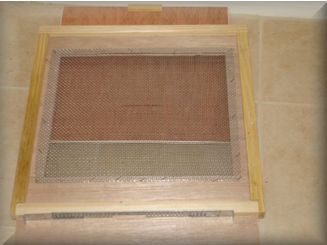
An open mesh floor with a removable tray
Varroacides Methods
Bayvarol: (95% success rate)
These are Plastic strips containing bayvarol, they are hung between the brood frames, and the chemical is spread by contact with the strip and other bees. It is used in the autumn or early spring for 6 weeks. It is safe to use during the honey flow.
Effective, but mites in the southwest and other areas of the UK have become resistant.
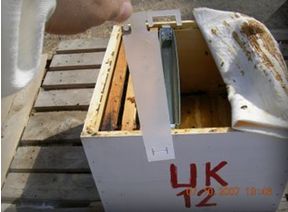
A Bayvarol Strip
Apistan: (95% success rate)
These are also Plastic strips hung between the brood frames and the Apistan is then spread by contact with the strip and other bees. Identically to Bayvarol, it should be used in the autumn or early spring for 6 to 8 weeks and is safe for use during the honey flow.
However, again like Bayvarol, whilst Apistan is mostly effective, unfortunately mites in the southwest and other areas of the UK have become resistant.
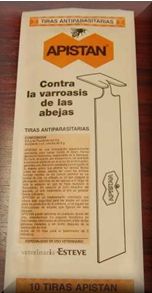
Apistan Strips
Apiguard: (90-95% success)
This is a slow release gel with two 50g pack treatments, it is spread by contact, evaporation and ingestion. Place the opened tray on top of the brood frames and replace the crown board. Use it in the spring or late summer after the honey harvest.
Efficient with optimum conditions, it can depend on bee activity and the temperature, and is best used with a varroa floor in and crown board vents covered.
It contains Thymol and cannot be used during the honey flow because it will taint the honey.

Opened Apiguard tray under the crown board
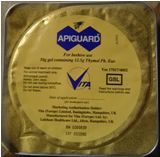
Apiguard Tray
Oxalic Acid: (90% success)
An acid solution trickled over the combs of bees, usually 2.5ml per brood comb, it is spread by bee contact. Use it in the winter and during broodless periods, because it could damage young immature bees in the cell.
There is a danger of colony weakening and best applied during the winter, usually December or January.
Cannot use during any honey flow as it is highly toxic. Always be sure to use protective equipment.
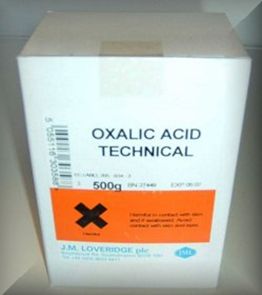
Oxalic Acid (can be purchased diluted and with a syringe)
Alternative Treatments
Sugar Dusting:
This method requires you to sprinkle castor or light sugar over the bee colony, this is to promote bee grooming which will cause the mites to fall off and through the wire mesh floor to its death. Needs to be used with a varroa floor to allow for mite drop or the mites will climb back up into the colony.
The down side is you cannot get the mite when there is brood because the mite uses the brood to breed, it only removes the mite on the bees.
There is no chemicals or dangerous effects on the bees, the only problem is you cannot get the sugar dust down through the frames where most of the bees are unless you dust each frame individually.
No scientific data is yet available on the efficiency or success rate of this method.
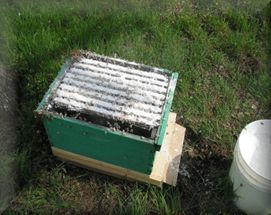
A sugar-dusted brood
Beevital Hiveclean:
Using this method requires you to trickle Beevital Hiveclean over the middle 7-8 brood frames. The substance is spread by the bees and activates bee grooming, initiating the cleaning instinct of the bees causing them to thoroughly clean themselves and the cells of the dead larvae.
Bees that are weakened or ill due to mite attack will leave the colony and may be observed in front of the hive.
Beevital changes the smell of the bee environment and the mite perception of this situation is that their food source has changed, this irritates the Varroa and they leave their hosts falling onto a sticky floor or through a mesh where they starve to death.
Use Beevital in July/August and again in November/December, but can be used anytime throughout the season including during the honey flow.
Produces no negative effect on the bees, brood or queen and is not a harsh medicine. It is made from natural elements and best results are obtained when used with a varroa floor. Comes in a 500ml bottle or in single-dose sachet sticks. Used by Austrian Organic Beekeepers and becoming increasingly popular in the UK.
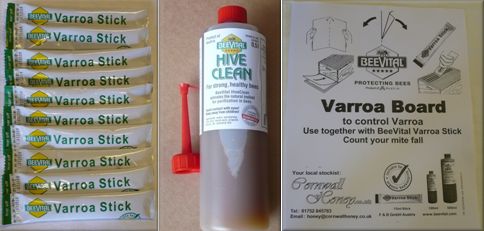
Beevital Hiveclean Products
Varroacides and the Law
Use only Irish authorised treatments and always follow the manufacturers instructions, making sure that you have reliable up to date information on the legal status of treatments you use.
Keep accurate records of what treatments you use, this is a legal requirement, because you could be requested to provide a sample of your honey for residue analysis.
Good Husbandary Practise:
- Monitor the infestation in your hives regularly.
- Practise integrated pest management using various methods.
- Slow the spread of resistant varroa.
- Use only UK recommended treatments.
- Rotate when possible two or more varrocides.
- Keep up to date with new treatments.
- Select for and retain bees that appear to show tolerance to varroa.
- Keep records of treatments used and when.
Remember!
To prevent the loss or collapse of your bee colonies make regular checks.
If you are going to keep bees look after them and be a conscientious keeper.
These fantastic insects are a very important part of our eco-structure and agriculture.
